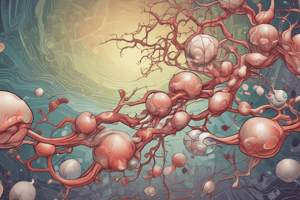Podcast
Questions and Answers
Which hormone is responsible for contraction of uterine smooth muscle?
Which hormone is responsible for contraction of uterine smooth muscle?
- Oxytocin (correct)
- Prolactin
- GH
- TSH
What is the most common cause of increased hormone production in hyperpituitarism?
What is the most common cause of increased hormone production in hyperpituitarism?
- Hyperplasia of posterior pituitary
- Anterior pituitary adenomas (correct)
- Hypothalamic disorders
- Malignancy of anterior pituitary
Which clinical syndrome results from sustained excess of growth hormone (GH) prior to epiphyseal closure?
Which clinical syndrome results from sustained excess of growth hormone (GH) prior to epiphyseal closure?
- Gigantism (correct)
- Hyperprolactinaemia
- Cushing’s syndrome
- Acromegaly
Which hormone is commonly associated with hyperprolactinaemia?
Which hormone is commonly associated with hyperprolactinaemia?
What are the main effects of VASOPRESSIN (ADH)?
What are the main effects of VASOPRESSIN (ADH)?
Which part of the pituitary gland is also known as neurohypophysis?
Which part of the pituitary gland is also known as neurohypophysis?
Which part of the pituitary gland consists of highly vascular epithelial cells?
Which part of the pituitary gland consists of highly vascular epithelial cells?
Which part of the pituitary gland is an upward extension from pars distalis that encircles the infundibulum?
Which part of the pituitary gland is an upward extension from pars distalis that encircles the infundibulum?
Which part of the pituitary gland lies posterior to the anterior lobe?
Which part of the pituitary gland lies posterior to the anterior lobe?
What is the connection between the pituitary and hypothalamus called?
What is the connection between the pituitary and hypothalamus called?
What is the stimulus for the vision sense organ?
What is the stimulus for the vision sense organ?
Which part of the eye protects the anterior part of the eye?
Which part of the eye protects the anterior part of the eye?
What is responsible for bringing light rays to focus on the retina?
What is responsible for bringing light rays to focus on the retina?
Where is the visual cortex located for the perception of visual stimuli?
Where is the visual cortex located for the perception of visual stimuli?
Which part of the eye is involved in lubricating and protecting the eye?
Which part of the eye is involved in lubricating and protecting the eye?
Which part of the eye plays a role in the accommodation process for focusing on objects at different distances?
Which part of the eye plays a role in the accommodation process for focusing on objects at different distances?
What is the function of the tear film?
What is the function of the tear film?
Which layer of the tear film acts as a lubricant for the movement of the lids over the cornea?
Which layer of the tear film acts as a lubricant for the movement of the lids over the cornea?
What contributes to the transparency of the cornea?
What contributes to the transparency of the cornea?
Which reflex protects the eye by causing reflexive closure of the eyelid?
Which reflex protects the eye by causing reflexive closure of the eyelid?
What is the primary function of the aqueous humor?
What is the primary function of the aqueous humor?
Which nerve is responsible for mydriasis and relaxation of ciliary muscles?
Which nerve is responsible for mydriasis and relaxation of ciliary muscles?
What is the pH of the tear film?
What is the pH of the tear film?
Which layer of the tear film is secreted by Meibomian glands and prevents evaporation of underlying layers?
Which layer of the tear film is secreted by Meibomian glands and prevents evaporation of underlying layers?
What covers and protects the cornea and conjunctiva, and is secreted from the lacrimal gland under the upper eyelid?
What covers and protects the cornea and conjunctiva, and is secreted from the lacrimal gland under the upper eyelid?
What removes cells, foreign bodies, irritant substances, and supplies the corneal wound with WBCs from blood?
What removes cells, foreign bodies, irritant substances, and supplies the corneal wound with WBCs from blood?
Flashcards are hidden until you start studying
Study Notes
Overview of the Pituitary Gland
- Known as the master of endocrine glands, coordinating various hormonal functions in the body.
- Structure: Oval and small, comparable to the size of a pea.
- Location: Attaches to the undersurface of the brain via the infundibulum (pituitary stalk).
Anatomy and Position
- Situated in the hypophyseal fossa of the sphenoid bone.
- Weighs approximately 0.5 grams.
- Positioned inferiorly to the diaphragma sellae, which is part of the dura mater.
Relations and Surrounding Structures
- Covered superiorly by the diaphragma sellae, which protects the pituitary gland.
- Separated from the floor of the fossa by a venous sinus located inferiorly.
- Lateral associations: Cavernous sinuses on each side, which contain various neural and vascular elements.
Important Landmarks
- Sulcus chiasmaticus: In proximity to the optic chiasm.
- Tuberculum sellae: Relatively close to the pituitary gland's location.
- Dorsum sellae: Positioned behind the pituitary fossa, providing structural support.
Visual Representation
- Reference to sagittal sections of head and neck for anatomical context and clarification of positioning.
Studying That Suits You
Use AI to generate personalized quizzes and flashcards to suit your learning preferences.




